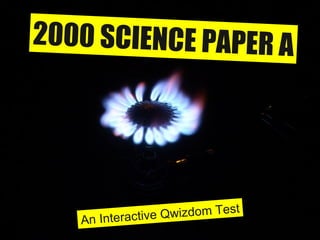
2000 science paper a - qwizdom ppt.
- 1. 2000 SCIENCE PAPER A An Interactive Qwizdom Test
- 2. 2000 Science Paper A Input your name and press send. Next Page
- 3. Next Page Water (a) Scott has a plastic bottle with water in it. He wants to freeze the water by putting the bottle in a freezer. Complete the labels by writing solid or liquid in each box. (i) The bottle before going into the freezer. 2000 Science Paper A Q1 Solid
- 4. Next Page Water (a) Scott has a plastic bottle with water in it. He wants to freeze the water by putting the bottle in a freezer. Complete the labels by writing solid or liquid in each box. (ii) The bottle just after being in the freezer for 24 hours.. 2000 Science Paper A Q1 Solid Solid
- 9. Smoking and Health (c) This graph shows how the number of adults smoking changed between 1974 and 1994. 2000 Science Paper A Q3 (i) Use the graph to describe the change in the number of adults who smoked between 1974 and 1994. Next Page (ii) Give ONE possible reason for this change.
- 10. Sounds (a) John makes a musical instrument using 5 sticks and a block of wood. 2000 Science Paper A Q4 To make a sound, he pushes a stick down and lets it go. Explain why the stick makes a sound. (b) How can he make the sound louder? (c) John finds that stick 5 makes the highest note. Describe how the length of the stick affects the pitch of the note. Next Page
- 12. 2000 Science Paper A Q5 Next Page Heart Rate Jim uses a sensor to measure his heart rate before he starts running. He starts running and measures his heart rate every five minutes. After his run, he draws a graph. Use the graph to help you answer these questions. (a) What is Jim's heart rate before he starts running?
- 13. 2000 Science Paper A Q5 Next Page (b) What happened to Jim's heart rate in the first five minutes that he was running? (c) Describe Jim's heart rate between points X and Y on the graph.
- 17. Growing Seeds (b) The seeds start to grow. Martin covers the seedlings with a polythene bag. Jane covers her seedlings with black paper. 2000 Science Paper A Q7 After a few days the leaves of Jane's seedlings are yellow. Why do the seedlings under the black paper have yellow leaves? Next Page (c) Martin's seedlings grow strong and healthy leaves. Explain why the leaves are important to a plant.
- 19. Water and Salt (a) Kiran puts 50cm3 of water in a plastic beaker. He puts it in a freezer. 2000 Science Paper A Q8 He looks at the freezer thermometer. What is the temperature in the freezer? … .. °C Next Page
- 21. (c) Kiran puts 50cm3 of water in another beaker. He adds 5g of salt. What happens to the salt when Kiran mixes it with the water? 2000 Science Paper A Q8 (d) Kiran leaves the beaker with water and salt in a warm place for a week. Complete the following sentence to describe what happens to the water. (i) The water Next Page
- 23. Flowers and Bees Kate and Simeon want to find out which colour flowers bees will visit most. They make model flowers of different colours. 2000 Science Paper A Q9 Bees feed on nectar from flowers. Kate and Simeon make their own nectar using 40g of sugar and 100cm3 of water. They put 10 drops of nectar in the centre of each model flower Next Page They put their flowers outside then count the bees that visit the flowers. They keep a record of the weather for each hour.
- 24. Flowers and Bees (a) Here are the children's results. 2000 Science Paper A Q9 Which colour of flower do the bees visit most? Next Page (b) Use the information on the table to say how the amount of sunshine affects the number of bees that visit the flowers. (2 marks) (c) Write TWO things that the children could keep the same to help make their test fair. (2 marks)
- 25. 2000 Science Paper A Q10 Next Page Temperature Sensor (a) In December, Jenny and Jayesh want to find out how the temperature inside and outside their classroom changes overnight. They connect two temperature sensors to their computer. They place one sensor on the table in their classroom and put one outside the window. This is the line graph that was recorded by the computer. In degrees Centigrade, what was the highest temperature recorded?
- 27. 2000 Science Paper A Q11 Next Page Parachutes (a) Some children make four paper parachutes. Each parachute has a different sized canopy. They drop each parachute from the same height. They measure how long it takes each parachute to reach the ground. Here is a table of their results. Which parachute took the longest time to reach the ground? Parachute Size (area) of canopy (cm 2 ) Time to reach ground (seconds) A 100 1.0 B 400 2.0 C 625 2.5 D 900 3.0
- 28. 2000 Science Paper A Q11 End of show Parachutes (b) The picture shows two forces acting on a parachute as it falls. What is the name of the force up? (Clue 2 words) (c) Look at the table of results. Describe how the time taken to reach the ground depends on the area of the canopy. (2 marks) Parachute Size (area) of canopy (cm 2 ) Time to reach ground (seconds) A 100 1.0 B 400 2.0 C 625 2.5 D 900 3.0
